Steady as she goes
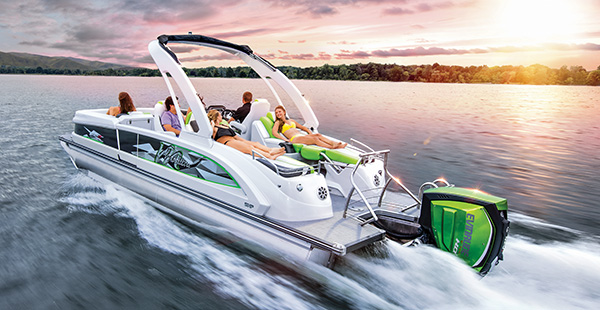
The pontoon boat segment was the first to recover in the wake of the downturn, and it continues to post steady and consistent sales growth year after year. Is this the new normal?
“We’re again looking at growth in the high single-digit range.”
“We expect growth to continue at the same rate, or even a little better than what we saw last year.”
“We have no reason to believe next year will be any different.”
For the past several years, statements such as these have been a part of virtually every conversation about the booming pontoon boat category.
Pontoon boat builders talk of expanding their plants to boost production, as former pontoon builders return to the segment with all-new models, and V-hull manufacturers leap into the fray with new pontoon lines of their own, some purchased and others home-grown.
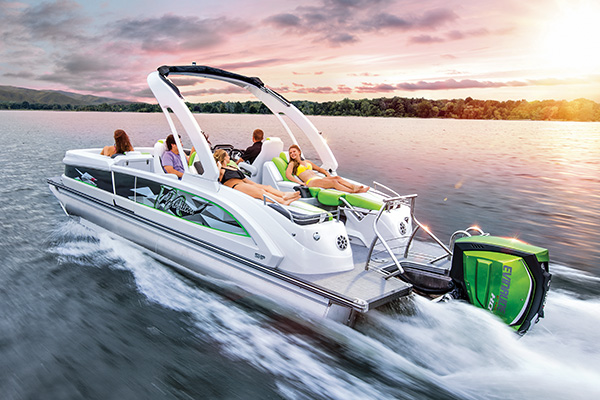
There’s no question that the pontoon boat market has provided the foundation for the resurgence of the recreational boating industry. The question in everyone’s minds, however, is how long can this go on?
In the years immediately following the downturn, there was some belief that the rapid growth in pontoon sales was just a bubble, one which would see its day in the sun then collapse under the weight of market saturation.
But no one believes that now, as it becomes increasingly clear that the once humble pontoon has completely replaced the formerly ubiquitous fiberglass runabout as the core of North America’s boating culture.
Pre- and post-downturn sales data support the notion that what we’re seeing is not a bubble at all, but a new state of normal in the recreational boating hierarchy.
According to Grand Rapids, Michigan-based Statistical Surveys Inc. (SSI), in 2005 American boat builders shipped more than 66,000 fiberglass runabouts and deck boats, compared to approximately 44,000 pontoons.
But since the downturn, things have shifted radically. The expectation for 2018 is that pontoon sales will climb to over 50,000 units, while sales of fiberglass runabouts and deck boats will top out somewhere in the 17,000- to 18,000-unit range. Where pontoon sales have now eclipsed their pre-downturn high water mark, sales of fiberglass runabouts remain only about one-third of their pre-downturn levels.
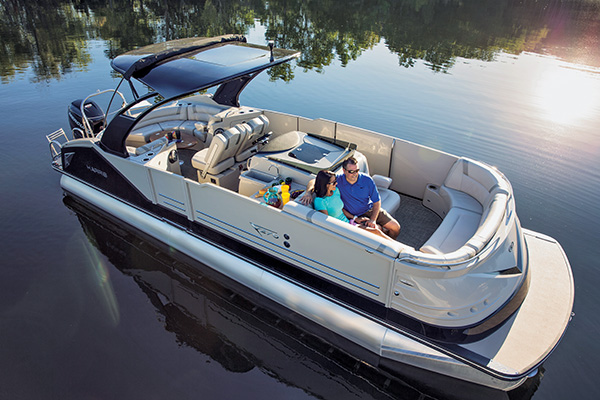
It’s a rate of change that may even be accelerating. SSI notes that for calendar year 2017, sales of pontoon boats in the U.S. grew by 7.20 percent overall, while sales of fiberglass runabouts and deck boats dipped by 4.09 percent.
On a 12-month rolling basis, pontoon boat sales increases were reported for virtually every Basic Trading Area (BTA) that SSI monitors, with the sole exception of Houston. Yet in spite of the catastrophic destruction caused to that region by Hurricane Harvey, pontoon sales in the Houston BTA dipped by only 2.33 percent below 2016 levels. Until the hurricane, the Houston BTA was trending to finish the year with positive growth too.
In other markets that enjoyed more stable weather, pontoon sales flourished, with double-digit year-over-year growth reported for markets like Atlanta, Birmingham, Milwaukee, Knoxville and New York. The Fort Wayne, Ind. BTA led the way in 2017, posting an astounding rolling YOY growth of 22.43 percent.
“We’re seeing strength at the retail level across the country, no question about it,” said Peter Barrett, senior vice president of marketing and corporate development at New Paris, Indiana-based Smoker Craft Inc., builder of the Starcraft, Sylvan and SunChaser pontoon lines. “The boomers are still active in the market, but we’re starting to see more younger buyers who recognize the do-it-all nature of these boats. They appreciate the pontoon’s ability to accept higher horsepower outboards that offer better performance, and they value being able to accommodate a lot of people on the boat. Pontoon boats are the SUV of the water right now, so they appeal to a diverse range of buyers.”
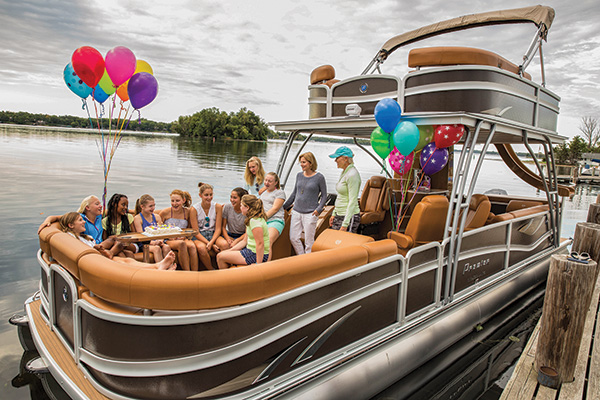
Versatility is key
Part of that growing appeal lies in the extreme adaptability of the pontoon platform. The same basic boat can be used with equal effectiveness for fishing, water sports, twilight cruises, taking the family for picnics on distant islands or just hanging out at the sandbar.
Boomers look at the pontoon’s wide entry gates as providing easy access for elderly relatives, and the flat floor being able to accommodate a wheelchair. Millennials see those same entry gates as offering easy dock-level access for a pregnant spouse, and the flat floor as able to accommodate a baby stroller. The same boat is seen by different buyers in entirely different ways.
“We really thought the market was going to be a big influx of boomers, all coming to that age where it’s time to retire and get something with greater stability, something that they can enjoy with their grandkids,” said Brunswick Freshwater Boat Group President Jeff Kinsey. “In fact, what we’re seeing are boomers, and millennials, and GenXer’s in between all participating in the same market at once. That’s extremely unusual. Pontoons are attracting a broad demographic range of buyers, and a large part of that is the result of their versatility.
“The other thing we’re seeing today is that people just are not overnighting on their boats like they used to,” Kinsey said. “There’s been a clear shift toward day boating, and that speaks directly to the pontoon with its seating capacity, its open space, its amenities and its comfort.”
Market data from the National Marine Manufacturer’s Association (NMMA) confirms the shift toward day boating and away from vessels with overnight accommodations.
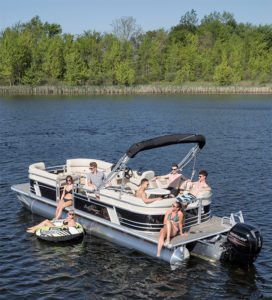
SunChaser features four wrap-around
loungers and seating for 14 passengers.
Over the past five years, pontoon boats have earned a market share in the range of 20 percent for all boats combined. Yet over the same period, market share for cruisers with overnight facilities has consistently held in the low single digit range. For example, in 2017, pontoon boats enjoyed a market share of 20.6 percent, compared against 3.2 percent for cruisers.
What’s even more interesting is the pontoon’s relative market share among boats powered by outboard engines. For 2017, pontoons represented nearly 32 percent of the outboard-powered market with a whopping 31.8 percent share – a figure that has been consistent across the past five years.
Designed for today’s buyer
The widespread appeal of pontoon boats is also supported by the sheer variety of models available in today’s market. Few other boat categories can claim to appeal across such a wide range of sizes, feature sets or price points.
“A lot of the conversation around pontoon boats in recent years has focused on high performance. While that’s an important part of the market, we have to remember that first-time buyers and young families with small kids aren’t starting out with fully loaded luxury models powered by twin 300s,” said Greg VanWagenen, director of marketing and communications for Manitou Pontoon Boats. “That said, they can buy a nice pontoon like our Aurora VP with a 150-horsepower engine for somewhere in the low to mid $30,000 range. A boat like that is absolutely comparable to what a runabout can offer in terms of speed and overall performance, plus it offers a lot more room for passengers and their gear. So I think buyers are starting to weigh those options as they shop different types of boats, and we’re seeing more of them gravitating toward pontoons than they used to.”
Apart from adaptability, practicality is also seen as a key element in the pontoon boat’s appeal, especially to younger buyers.
“We’ve had a good following with the millennial group, mostly because the pontoon boat seems to be a no-nonsense purchase,” said Premier Pontoons President Lori Melbostad. “It’s something that’s functional, and versatile enough to be able to do it all. We have good following among the mid- to late 20 year-old group that doesn’t just want a water sports boat. They’re looking for something that can do a lot of other things as well, and that’s where a pontoon really delivers.”
While it is possible to find pontoon boats today ranging from less than 16 feet to more than 33 feet in length, the core of the market is represented by boats in the 21- to 26-foot range.
NMMA pegs boats in this class as accounting for nearly three quarters of all pontoon sales in 2017. SSI notes that 23-foot and 25-foot boats led all other lengths in sales growth, posting year-over-year gains of 18.15 percent and 14.02 percent respectively. These boats represent the sweet spot in the pontoon market, being large enough to handle bigger outboards and offer performance, while remaining trim enough to meet a range of price points and allow for sales volumes.
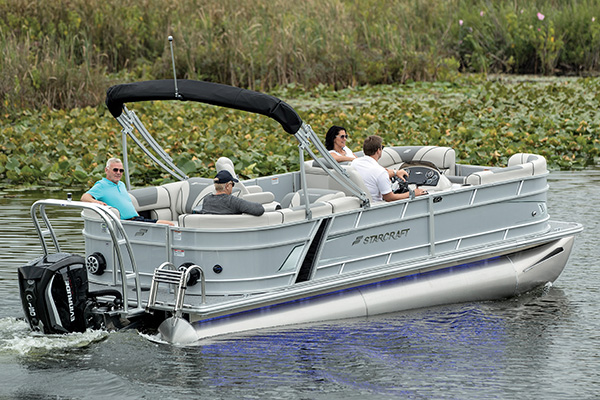
“Sales of higher horsepower boats are off the charts,” Melbostad said. “We’ve never seen them this strong. Dealers are not afraid of stocking boats that are going to be equipped with the higher horsepower motors because they know they’re going to sell them easily. Our overall volumes are down this year because of the company’s reorganization, but mid-line boats with a powerful engine on them … they’re the meat-and-potatoes boats. The reality is that not everyone is going to buy a 12-foot wide pontoon boat with triple engines on it, but everyone wants some level of performance.”
Achieving that magical balance between performance and affordability has been key for pontoon builders. “There’s a lot of recent attention on high-end boats that go 60 or 70 miles an hour with twin engines and triple tubes,” Kinsey said. “But the great thing about a pontoon is you don’t have to go that way to have fun on the water. You can get a basic boat with a single 200 horsepower outboard and still enjoy excellent performance. You can go fast, you can do water sports, but you can also just relax and enjoy the day. Pontoons allow consumers to enjoy a bit of performance while still having all the seating and all the features, and they offer that over a wide range of price points.”
While the trend toward higher horsepower began years ago, a newer evolution is taking place at the back of the boat where the traditional twin loungers are increasingly giving way to more adaptable seating arrangements, suiting the demands of today’s buyer. “We see a lot of customers gravitating toward boats with more utility in the stern, whether it’s aft-facing seating that overlooks the back deck, or more versatile seating like lounges that convert into a table,” Barrett said. “We’re seeing more demand for innovative furniture and layouts that can serve multiple functions. We’re also seeing a lot of growth in our higher-end fishing pontoons, which offer plusher features, bigger fishing seats and more versatility that what you can get with a standard back seat.”
With their comparatively modular construction, builders generally have an easier time reconfiguring pontoons with furniture changes or feature upgrades that they do reconfiguring comparable fiberglass boats, which might require significant changes to the deck molds. This not only allows for more rapid product development and evolution, it also provides manufacturers with a means of achieving a level of mass customization. “We’re seeing some customers looking to customize the rail color, or the panel colors, for example,” Barrett said. “Other customers look for custom interior colors and different flooring options, and we can provide those with a pontoon boat.”

The look ahead
A stable economy, continuing low interest rates, comparatively low fuel prices and robust consumer confidence give little reason to believe that the annual growth in the mid- to high-single-digit range that we’ve seen in the pontoon segment over the last several years is likely to change.
If anything, North American sales of pontoon boats could grow further as the Canadian economy picks up steam.
According to NMMA Canada’s 2017 Statistical Abstract, retail dollar sales for new boats and outboard engines in the Canadian market totaled $2.3 billion in 2016, a 9.2 percent increase over the previous year. Outboard engine sales were up in nearly all provinces, with growth led by Ontario (up 8.3 percent), British Columbia (up 7.8 percent), the Atlantic provinces (up 7.1 percent) and the Northwest Territories (up 7.8 percent).
“The Ontario east market has been huge for us this year,” said VanWagenen. “I think we signed 10 or 12 new dealers in those provinces just in the last year or so.”
There is also potential for further market growth here in the U.S., as anticipated tax reductions could further boost consumer confidence.
For now, though, it’s steady as she goes for the pontoon category, and a promise of smooth sailing for at least another year.




